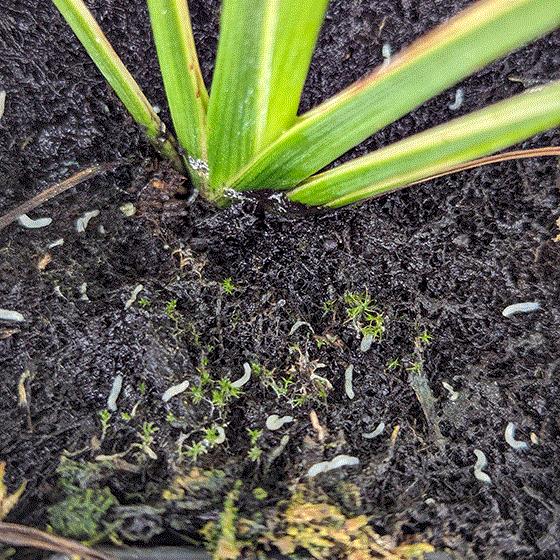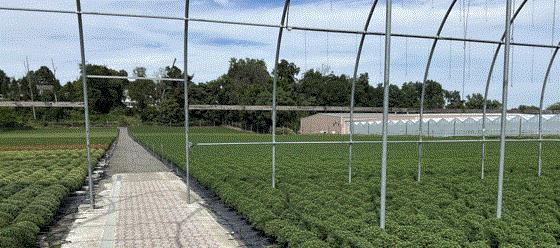NEW PODCAST: Managing Whitefly (and more) on Poinsettias
For episode #185, Corteva’s technical guru, flower grower and greenhouse and nursery “coach” Broch Martindale is back with me on the Tech On Demand podcast to share strategies for controlling and preventing some of the more common pest and disease challenges you might face in poinsettia production—such as whiteflies and powdery mildew—using chemistries like XXpire, Floxcor and Eagle.

Links to the podcast are below. We also recorded this as a VIDEO if you’d prefer to watch and listen.
Over the course of this episode, Broch and I discuss safely using chemistries in rotation and what chemistries are appropriate for poinsettias late in production (when bracts are in color), as well as specific active ingredients that have been successfully trialed and tested to tackle common but challenging greenhouse pests.
Throughout the podcast, Broch offers tips and tricks he’s turned to over the years producing crops and working with growers to manage and prevent pests when producing everyone’s favorite holiday crop.
Also, be sure to read KEEPING POINSETTIAS MERRY AND BRIGHT in the May 2025 issue of GrowerTalks for more from Broch on this topic.

Koppert Corner: Prevent Fungus Gnat Larvae
It’s that time of the year again—poinsettias! And with poinsettias come fungus gnats, resulting in serious consequences if they’re not effectively managed during propagation and early plant establishment.
Whether rooting your own poinsettia cuttings or bringing in rooted liners to plant and finish, early fungus gnat management is critical. Why? Because fungus gnat larvae feed on plant roots. They create wounds that are potential entry points for plant pathogens. Getting a grip early in the crop cycle prevents root damage and reduces root disease development later in production.

What is your best approach? You need to attack at least two of the three life stages at once to effectively interrupt the pest lifecycle and reduce fungus gnat populations. Without attacking multiple life stages at the same time, you’ll find yourself in a game of whack-a-mole (or whack-a-gnat), leading to ineffective control and root damage.
Entomopathogenic nematodes Steinernema feltiae (Entonem) are deadly to fungus gnat larvae. When stored, handled and deployed according to directions, one application of nematodes can achieve a 100% control result. However, nematodes are not a one-and-done solution. Adults continue to fly and drop into the root zone to lay more eggs so it’s critical to attack both adult and larval stages at the same time with consistency. Weekly spray/sprench applications break the lifecycle.
If you’re currently drenching Bt israeliensis, Cyromazine, Pyriproxyfen or another insect growth regulator (IGR) as your sole means of managing fungus gnats, you’re only doing half the work needed for effective control. Adult fungus gnats aren’t being targeted. One strategy to remove adult fungus gnats from the crop is to mass capture them by hanging RollerTrap or Yellow Horiver Wetstick or Drystick cards.
Not able to hang tape or mass-capturing cards? A great alternative is a weekly sprench of Isarid. Its strength is that it infects all fungus gnat life stages, both above and below the media surface. You can see it working in the photo above—the larvae are milky white and fuzzy once infected.
Have more questions about managing fungus gnats on poinsettias or other summer crops? Reach out to a Koppert technical consultant in your area and let’s start a conversation!

Nick’s Tip of the Week: Garden Mums & Summer Heat
Each week, I’ll work with my buddy Nick Flax, a technical services expert at Ball Seed, to share a concern that’s come up during one of his numerous calls with growers across North America. Weather has been weird over the past month, and with hot weather hitting some regions for the first time this week, he wanted to run a reminder of some ways to beat the heat when producing mums in summer.
PROBLEM: You may or may not be experiencing high heat yet, but chances are it’s on the way—and your mums will be impacted. If you or your mum team are wondering what to do when temps spike, here’s a run-down on physiology, growth and some disease factors to consider. Mums can’t head to the mountains or the lake to cool off, but there are strategies you and your team can turn to when the sun is blazing.

NICK’S TIP: A lot of research has focused on flowering heat delay, but let’s dig into other production concerns and discuss the pros and cons of strategies to manage these in extreme heat scenarios.
Plant Physiology
All plants have optimal temperature ranges for growth and development, both of which slow or can be altered when temps are outside of this range. For garden mums, the optimum range for vegetative growth is about 65 to 75F (18.3 to 23.9C). When temps are below the low end of this range, vegetative growth slows, and flowering induces (this is why crown budding occurs in summer after a few cold nights). Above the maximum in this temp range, flowering delay can occur, but vegetative growth slows or stops completely once temps reach a certain threshold.
Growth & Development Impact
Above about 86F (30C) is where growth and development of mums really start to grind to a halt. Stomata (gas exchange sites on leaves) close, and chlorophyll, enzymes and other organelles can start to degrade. This means the internal “bio-machinery” of your crop is getting damaged and shutting down. When temps exceed the upper 80s F (30 to 32C) for extended periods, be sure to take the following steps:
Shade your mums (not to be confused with the term “shaded mums”—inducing early flowering using blackout cloth) if growing in a greenhouse. Aluminized shadecloth will help reflect the heat load and help reduce the chances of physiological injury. Shadecloth or white shading compound over the top of your greenhouse will also help reduce temps. If growing mums outdoors, shading options are limited. Shadecloth suspended above the crop will be helpful, but black shade netting hanging right above the plants will likely increase the temperature due to the black material absorbing heat AND restrict air flow.
Consider doing a few canopy “cool-down” sprays during the day. While there isn’t really any research that supports the effectiveness of this strategy in mum production, the physics behind evaporative cooling (phase change of water from liquid to gas absorbs heat) are undeniably true. If shading is not an option for your crop, this may be a better option than doing nothing and letting your mums cook in the extreme heat.
If you attempt this strategy, spray down plants with cool water using the finest droplet size you can. Smaller droplets will evaporate more readily—even if humidity is high—and reduce the addition of water to the growing media.
-
If it’s rained recently, additional misting will not be very effective and may just increase the risk of foliar disease, so only attempt this on dry, sunny days.
-
Because increased foliar wetness increases the risk of disease, be sure to reapply foliar protectants at appropriate labeled intervals when the air temp cools down.
Elevated temperature also means water in the growing media will be taken up and/or evaporate more quickly. Avoid letting plants dry down to the “flagging” or true wilting point under extremely high temps, or roots may be damaged, and recovery delayed.
Time your irrigations carefully. Mums do not like having soggy soil, so while you may feel that watering three or more times per day is helping keep your crop cool, you may be causing more problems by starving the roots of oxygen. However, waiting until soil is at a moisture level 2 (on the 1–5 scale; 1 = air dry, 5 = saturated) or lower under extreme heat may make it impossible to keep up with the crop's demand plus evaporated water loss and result in irreparable wilting. Start on the wetter side and carefully increase time between irrigations to allow some dry-down. For example, wait until plants are at least at a moisture level 3 before watering again, rather than re-watering at level 4 or higher.
Disease Management
Stressed plants are always at higher risk for infection by different pathogens. Most diseases that impact garden mums prefer moderate to warm temperatures, but a couple of pathogens can cause major problems under extreme heat conditions. Also, damage incurred during extreme heat events can prime your crop for infection once temperatures return to normal, so be prepared.
Bacterial soft rots such as Dickeya and Erwinia/Pectobacterium often prefer hot temperatures and high moisture levels. If you start to see leaves and shoots browning and collapsing quickly, and symptomatic tissue has a strong, nasty odor, one of these bacteria is likely the culprit. Remove affected plants ASAP (throw away media, containers and all—DO NOT compost them) and apply a registered bactericide to reduce spread.
Get your disease prevention tools ready and consider doing some early, preventative applications of root zone protectants as soon as temperatures start returning to normal.

VIDEO: Programming Day of the Dead Marigolds
I got an email from our friends at Syngenta sharing production strategies to successfully grow marigolds for Dia de los Muertos (Day of the Dead) promotions. The holiday falls on November 1-2 this year and there’s still time to order marigolds and time your crop to fill endcaps. Seeds need to be sown by Week 33 and plugs transplanted by Week 37 (based on research using Inca II African marigolds), according to Syngenta’s programming guidelines.

One of my favorite technical experts to learn from—Dr. Jamie Gibson—shared just about everything you need to know about producing Day of the Dead marigolds for late-October sales using Syngenta genetics (Antigua for small pots and Inca II for larger containers) in a new five-minute video titled DAY OF THE DEAD MARIGOLD PROGRAMS. Check it out!
Webinar: Optimize Your Time in Columbus
This is definitely not cultural/technical related, but as a longtime Cultivate (aka OFA Short Course) attendee, I know how crazy the event can be, so when I saw that there’s a webinar coming up to help you navigate the show, I wanted to share it.
I’ve been to more than 20 Short Course/Cultivate events and some years I attack the show with a plan and other years I either wing it or I fail to stick to my carefully planned calendar of sessions, receptions and booth visits. But without a plan, there’s so much going and so many people to chat with that before you know it the event is over and you didn’t accomplish the goals you set.

Thankfully, the folks at AmericanHort understand the challenge and have scheduled A WEBINAR for Wednesday, June 25 from 1-2 p.m. EST to help you and your staff get the most out of your Cultivate’25 experience. As they mentioned, this webinar is ideal for first-timers but also for seasoned veterans (like me) who might benefit from a gameplan before this year’s event.
NOTE: This webinar is only available to AmericanHort members. Personally, I think that everyone in our industry should be a member … but that’s your call.
Here's what AmericanHort said you can expect from the webinar:
-
Get the inside scoop on everything you need to know about Cultivate’25, including the trade show, keynote speakers, educational sessions, tours, workshops, evening events and more.
-
Learn how to effectively plan your days using the MyShow Planner online tool to ensure you make the most of every opportunity.
-
Hear insights from seasoned Cultivate attendees on how to leverage the event for your company, your career and your personal growth.
-
Discover smart strategies for identifying the most relevant exhibitors and educational sessions to visit, so you can grow your network and drive business results.
-
Gain invaluable tips on navigating the bustling Columbus Convention Center and exploring the vibrant Short North District.
-
Participate in an interactive Q&A session where you can ask questions and receive expert advice on maximizing your Cultivate experience.

Finish Line …
Each year before awarding the coveted Young Grower Award to one of three finalists, GrowerTalks’ editors ask them to respond to a big-picture industry question, and we publish their responses in the June issue of the magazine. I was excited to read this year’s finalists’ thoughts on the question "What are the three most impactful things greenhouse businesses can do over the next couple years to be successful?" Their thoughtful and insightful ideas did not disappoint, that’s for sure!

Be sure to read MAKING AN IMPACT when you get a chance to open up your June issue. Or just click the link above to view the article digitally. Some of their thoughts did overlap, which probably means they’re onto something, but there are some outside-the-box comments as well. From leveraging technology and crop diversification to sustainability and mentoring, you’ll be impressed with our three finalists—and you might just find an idea to implement in your own strategic planning!
Talk to you next Friday!




Please feel free to send your comments, constructive criticism and topic ideas to me at bcalkins@ballhort.com.

Bill Calkins
Editor - Tech On Demand
This email was received by you and 25,579 other fine subscribers!
If you're interested in advertising in Tech On Demand, contact Kim Brown ASAP and she'll hook you up.